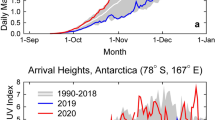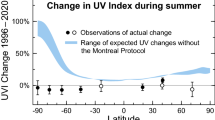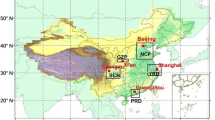Abstract
The paper presents the results of calculations of the dynamics of ozone destruction in the lower stratosphere, carried out taking into account the heterogeneous chemical reactions (HCRs) proceeding at a rate of w(–O3)HCRs, cm–3 s–1, with the participation of particles of the Junge layer (background aerosol). The dramatic decline in w(–O3)HCRs found in the calculations at altitudes less than 16 km in comparison with the rate of ozone loss calculated with the participation of gaseous chemical reactions (w(–O3)) indicates the inhibitory role of aerosol particles. This is due to the capture of N2O5 molecules from the air by aerosol particles. Their rapid runoff entails a sharp decrease in the concentrations of components of the NOx family in air, as well as a less pronounced decrease in the concentrations of components of the HOx, and Ox families involved in the destruction of ozone. At higher altitudes of 16 to 22 km, magnitude w(–O3)HCRs, in contrast, turns out to be slightly higher than w(–O3); and it affects the acceleration of the destruction process with the components of the HOx and ClOx families. The increased level of their concentrations and rates of reactions with ozone is due to the reduced content of the components of the NOx family in the air. This positive effect of the HCRs involving aerosol particles in w(–O3)HCRs practically degenerates, but at even higher altitudes. This is due to the decrease in the content of aerosol particles and the acceleration of the photodissociation of molecules N2O5(g) \(\xrightarrow{{h{{\nu }}}}\) NO3(g) + NO2(g), which on the whole is accompanied by the suppression of the process of their capture by particles.


Similar content being viewed by others
REFERENCES
I. K. Larin, A. E. Aloyan, and A. N. Ermakov, Khim. Fiz. 36 (1), 90 (2017).
C. E. Junge, C. W. Chagnon, and J. E. Manson, J. Meteorol. 18, 81 (1961).
I. V. Kumpanenko, A. V. Roshchin, N. A. Ivanova, E. I. Zelenina, T. C. Volchenko, and E. O. Panin, Russ. J. Phys. Chem. B 12, 58 (2018).
V. V. Zelenov, E. V. Aparina, V. I. Kozlovskiy, I. V. Sulimenkov, and A. E. Nosyrev, Russ. J. Phys. Chem. B 12, 343 (2018).
A. E. Aloyan, A. N. Yermakov, and V. O. Arutyunyan, Russ. J. Phys. Chem. B 13, 214 (2019).
R. J. Salawitch, S. C. Wofsy, P. O. Wennberg, et al., Geophys. Res. Lett. 21, 2547 (1994).
I. K. Larin, A. E. Aloyan, and A. N. Ermakov, Russ. J. Phys. Chem. B 10, 860 (2016).
C. Voigt, H. Schlager, B. P. Luo, et al., Atmos. Chem. Phys. 5, 1371 (2005).
http://dataportal.ucar.edu/metadata/acd/software/Socrates/Socrates.thredds.xml.
G. Myhre, T. F. Berglen, C. L. E. Myhre, et al., Tellus 56B, 294 (2004).
D. R. Hanson, J. Phys. Chem. A 102, 4794 (1998).
Q. Shi, J. T. Jayne, C. E. Kolb, et al., J. Geophys. Res. 106, 24259 (2001).
I. K. Larin, Russ. J. Phys. Chem. B 11, 189 (2017).
G. Brasseur and S. Solomon, Aeronomy of the Middle Atmosphere: Chemistry and Physics of the Stratosphere and Mesosphere, 3rd ed. (Springer, Montreal, Canada, 2005).
D. J. Jacob, Introduction to Atmospheric Chemistry (Princeton Univ. Press, Princeton, 1999).
T. Shimazaki, Minor Constituents in the Middle Atmosphere (Terra Sci., Tokyo, Japan, 1985).
K. S. Carslaw, T. Peter, and S. L. Clegg, Rev. Geophys. 35, 125 (1997).
Funding
This study was supported by the Russian Foundation for Basic Research (project nos. 19-05-00080 and 19-05-50007 (Microworld)) and a state assignment of Semenov Federal Research Center for Chemical Physics, Russian Academy of Sciences (registration number AAAA-A20-120011390097-9).
Author information
Authors and Affiliations
Corresponding authors
Rights and permissions
About this article
Cite this article
Larin, I.K., Aloyan, A.E. & Ermakov, A.N. Influence of Particles of the Junge Layer on the Rate of Ozone Destruction in the Lower Stratosphere. Russ. J. Phys. Chem. B 15, 577–581 (2021). https://doi.org/10.1134/S199079312103009X
Received:
Revised:
Accepted:
Published:
Issue Date:
DOI: https://doi.org/10.1134/S199079312103009X




